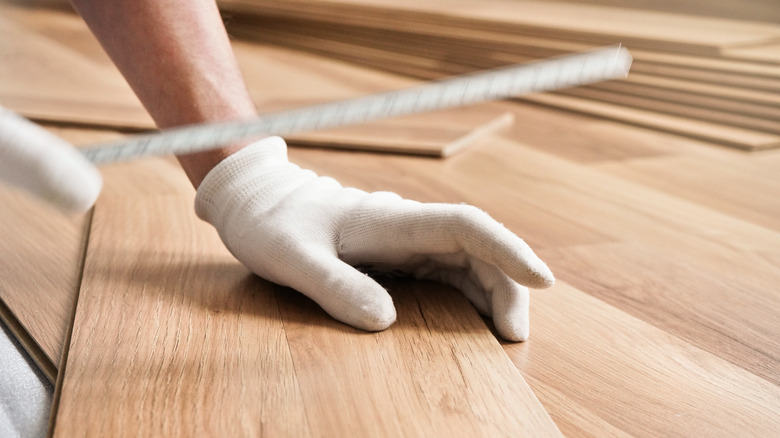Can You Seal The Seams Of Laminate Flooring?
We may receive a commission on purchases made from links.
When a laminate floor has been installed correctly, there are no seams between the planks to fill, either along the side joints or the end joints. When gaps develop, it's usually due to a problem with the subfloor material or the installation method. Even if they made a sealer for these gaps, you wouldn't want to use it. Besides the fact that such a sealer would probably make a mess of the floor, it wouldn't address the underlying cause of the gaps, which would just get worse.
Tip
You can seal the expansion gaps around the edges of laminate flooring, if desired, but you don't need to seal the seams between the pieces of laminate flooring.
Sealing Expansion Gaps
Sealing Expansion Gaps
Sealing the expansion gap around the perimeter of the floor, which is usually covered by baseboard, is a different matter. A sufficiently flexible silicone sealer that allows the flooring to move can help to prevent water from seeping under the flooring and is good protection in areas prone to spills and moisture, such as kitchens and bathrooms. Laminate manufacturers, such as Pergo, provide a sealant for laminate flooring with silicone, and it's as easy to use as silicone caulk.
When to Seal Laminate Flooring
When to Seal Laminate Flooring
You can seal the perimeter of a laminate floor any time, but the best time to do it is just after you've finished laying the laminate floor and before you install the baseboards. If you've done a correct installation, you've left a 1/4- to 3/8-inch-wide expansion gap around the edges of the room. You may have placed flooring spacers to maintain this gap. It's important to remove the spacers before you seal the gap or install the baseboards.
There's nothing to stop you from sealing the edges of an existing floor, even if it's a few years old, but it involves more work because you have to remove the baseboards to do it. They may be caulked to the wall, so the process can be messy. In a room with a lot of corners, keeping track of the individual pieces can be difficult. It's a good idea to number each baseboard piece when you remove it so you can remember where it goes.
Silicone Sealant for Laminate Flooring
Silicone Sealant for Laminate Flooring
A typical sealant comes in a tube and you apply it with a caulking gun, but you may find some foam sealants that you can spray from an aerosol can. Check the floor manufacturer's recommendations for sealants to be sure you get the right one because not all sealants are compatible with all brands of flooring.
Once the baseboard is off, apply caulk-style sealant as if you were caulking a piece of trim. The material should completely fill the gap, but it should remain below the level of the flooring. There's no need to tool it with your finger, and you don't have to wait for it to set before you replace the baseboards. If you're using spray foam, it may be a little harder to handle, so be sure to read the instructions on the container carefully before you use it.
Skip Sealing the Whole Floor
Skip Sealing the Whole Floor
Unlike hardwood flooring, which needs to be sealed to protect the wood, laminate flooring comes with a coating of very hard plastic resin and doesn't need to be sealed. Even if you apply a standard wood flooring finish, such as polyurethane, this does not guarantee that the surface will be waterproof. Floor finishes are not designed to seal joints and gaps between boards, especially with materials like laminate that typically are installed as a floating floor, which means the planks move slightly underfoot. Furthermore, if you apply a sealant over the entire floor, it could void the flooring manufacturer's warranty. It's best to skip sealing the entire floor.
End Joint Gaps
End Joint Gaps
If gaps are evident between the end joints between the laminate planks, it's often because the planks are moving lengthwise, and a sealer for laminate flooring won't help. The way to fix these gaps is to remove the baseboards and tap the planks lengthwise with a laminate pull bar and a hammer to close the gaps. Apply silicone sealant to the edges of the floor to stop the planks from moving and to prevent the gaps from reappearing.
